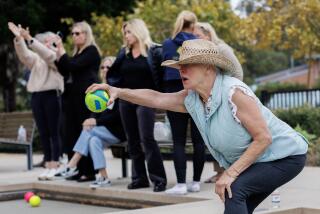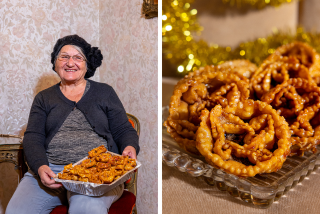The Bocce Boom : Once the Game of Italians and Old-Timers, Others Are Being Bowled Over by It
- Share via
Their duel in the late-afternoon sun had all the makings of a holy war.
With the resolve of St. Peter, Sister Teresa Colosio slowly curled her fingers around a green bocce ball, then gently rolled it within inches of the pallino, or smaller target ball, 50 feet away.
“Buono, buono, “ said the Italian-born nun, playing to an approving courtside audience at the Villa Scalabrini retirement home in Sun Valley.
Now it was Father August Feccia’s turn to roll. Like an avenging angel, the bespectacled priest decided to knock (bocce) the sister’s ball out of the way.
“Many times the best offense is a good defense,” said Feccia.
In this case, the priest’s strategy worked a little too well. His rapid underhand toss was delivered with such force that both bocce balls ricocheted off the sideboards and leaped out of bounds.
“Boccia morta (dead ball),” pronounced Sister Teresa, who is as comfortable in full habit as a layman in a jogging suit.
Her teammate, Sam Costanzo, 85, shouted encouragement. Dominick Tummillo, 81, did the same for his partner, Feccia.
The two holy leaders retrieved their balls and prepared to resume battle, their goal agonizingly simple: to knock their adversary’s balls away from the tiny pallino while remaining close to it themselves.
“The game is in our blood, our heritage,” said Tummillo, who first played as a boy in Southern Italy.
But the sport of bocce is no longer the exclusive turf of Italians, Catholics and old-timers. It’s gone upscale.
At the Market Street Cafe, a trendy Pasadena eatery where wine spritzers and topsiders are the fashion, restaurant-goers play bocce on a single outdoor court next to the bar.
Carrie Russell, a La Canada art consultant, said she stumbled on the game one night after the restaurant’s hostess told her there would be a 45-minute wait for a table.
“I didn’t want to have another glass of wine, so I was looking for something to do,” said Russell, who often coaxes friends into a spirited game or two before dinner.
“I love the game; it’s so simple, kinda like pitching pennies or horseshoes,” she said.
Sal Casola, the restaurant’s owner, said he’s never regretted putting a bocce court in the restaurant even though it meant losing a few money-making dining tables.
“I wanted it, and I thought there was a need for it, so I did it,” said Casola, who grew up playing the game behind his grandfather’s house in New York.
Players at Market Street exchange their driver’s licenses for a set of eight bocce balls the size of small coconuts. The manager on duty provides lessons for beginners.
Casola is among the latest to jump on the bocce bandwagon. From penthouses (the seventh-floor rooftop court at the San Francisco law firm of Coblentz, Cahen, McCabe and Bryer) to prisons like the one in Marion, Ill., where Pete Rose hangs his hat, the sport of bocce is booming.
The U.S. Bocce Federation (USBF), based in Martinez, Calif., was so confident of bocce’s growing popularity that it launched its own magazine in 1989.
“We already have a mailing list of 5,000,” said Ken Dothee, a Martinez public defender and USBF president. “NBC called us the sport of the ‘90s, Fortune magazine predicted bocce would become more popular than golf and the International Olympic Committee has bestowed official recognition on the sport.”
Reflecting the bocce trend, Forster Mfg. Co. Inc., the world’s largest maker of croquet sets, came out last year with a high-end bocce set manufactured at its Wilton, Me., plant. Previously, Forster imported these quality sets from Italy.
“I would venture to say that bocce in the next few years will grow at a higher percentage rate than croquet,” said Dick Corbin, Forster’s president.
Forster’s product manager, Bob Dionne, cited several reasons fueling interest in bocce. “Bocce is a highly portable game with simple rules that can be played on nearly any surface,” Dionne said. “It also has been adopted by a new generation of Americans whose interests have turned to the family and ‘cocooning.’
“The game is really about getting back to the basics,” he added.
And bocce is about as basic as you can get, with roots going back to ancient civilization.
According to Steve Candotti, the USBF’s official historian, accounts of the Punic Wars tell of Roman soldiers passing the time between battles pitching rocks at smaller stones.
Charles IV banned the sport in the mid-1300s so that his subjects could concentrate on war. Similarly, Henry VIII of England, who “bowled” on private courts at Whitehall, prohibited bocce for fear the game would detract from archery practice and lead to excessive gambling.
Candotti also traces bocce to the evolution of a number of other similar games, such as lawn bowling (England and Scotland), nine-pins and skittles (Holland) and petanque (France). Further, he ties the essentially American sport of bowling to the classic game of bocce.
“But please don’t compare bocce to bowling,” protested John Billotti, organizer of the bocce tournaments at the Garabaldina Society in Los Angeles. “With bowling, you throw one ball, sit down and wait for a new rack. There’s no strategy.”
The Garabaldina Society, founded in 1877 near Olvera Street before moving to 4533 N. Figueroa St. in the early 1900s, is probably the epicenter of the bocce-playing world in Southern California.
Every Thursday, players divide into four-man teams to compete on regulation 12-by-60 foot indoor courts of compacted clay and crushed gravel that are tamped down every night with a lawn roller.
Paulina Galazzo rarely misses a Thursday at the private Italian club. “For one thing, it’s good exercise,” she said, “and for another, when you’re playing, you think of nothing except that bocce ball.”
Another longtime member, Frank Crosetti, couldn’t always make his Thursday court dates, so he and 11 other Italian-American families from Los Angeles built a bocce court on a vacant lot next to their retirement apartment building in Oxnard Shores.
Ironically, that lot where Crosetti has rolled so many memories, is now attracting offers of up to $400,000 from other developers, a sharp increase from the original purchase price of $12,500 in 1962.
“We’ll hang on to it for as long as we can,” Crosetti, 77, said. “But some day, we’ll need the money.”
Of course, bocce buffs don’t require a court at all, just a level stretch of dirt or grass. “We didn’t actually have a bocce court when I was growing up,” said Galazzo, a native of Corona. “We would just play out in the front yard or wherever we could. But we always played.”
To win at bocce, players often invoke the name of their favorite saint, Billotti said. “Bocce is like rolling the dice. Until the balls stop bouncing around, you don’t know which team will take the points.”
Frank Grea, one of Billotti’s bocce pals, wanted to agree, then hedged a little. “You have to have luck,” Grea conceded. “But if you play long enough, the skill will beat you.”
Almost any Italian deli or specialty shop will sell bocce ball sets for anywhere from $40 to $100. Budget-minded players can substitute croquet balls for bocce balls and a cue ball for the pallino and will hardly notice the difference.
These are a few places that feature bocce ball:
* Claros, 19 1/2 E. Huntington Drive, Arcadia. (818) 446-0275.
* Claros, 1003 E. Valley Blvd., San Gabriel. (818) 288-2026.
* The Garabaldina Society, (213) 223-5005,
* Monte Carlo Deli, 3103 W. Magnolia Blvd., Burbank. (818) 845-3516.
* Sal’s Italian Market, 11917 Paramount Blvd., Downey. (213) 923-0780.
* The Venice Pavilion, 15030 Ocean Front Walk, Venice. (213) 399-2775.
For more information, write the United States Bocce Federation at 2239 Orange St., Martinez, Calif., 94553. Telephone: (415) 229-2157.
More to Read
Sign up for Essential California
The most important California stories and recommendations in your inbox every morning.
You may occasionally receive promotional content from the Los Angeles Times.













